With fewer than 500 days left until the 2020 election, the Democrats will participate in their first round of primary debates starting tonight. Over the course of two nights, 20 Democrats will take the stage to face off against each other, against the candidates participating in the debate on the opposite night, and against the president. This marks a true opening salvo for the 2020 presidential campaign that provides insight into the candidates’ abilities, as well as the tone and tenor of the race.
The path to the first debate
Since then-Rep. John Delaney (D-Md.) announced his presidential bid in July 2017, he has been joined by 22 other Democrats and an Independent seeking their party’s 2020 presidential nomination. While some candidates like former Vice President Joe Biden, Massachusetts Senator Elizabeth Warren, and Vermont Senator Bernie Sanders are well-known figures, most of these candidates remain anonymous to the American public. These debates will be the first chance candidates have to introduce themselves to a large audience.
This campaign has presented some challenges for the Democratic National Committee. After allegations of favoritism in the 2016 race, the new chairman of the Democratic Party, Tom Perez, has gone out of his way to demonstrate fairness and parity. The size of the field has made the management of a debate unwieldy, forcing the party to use two debates over two nights.
Split debates are not unprecedented, as Republicans utilized the same model in 2016. Yet, the DNC recognized that the Republican model was flawed and could create questions over fairness. The Republican model packed all of the leading candidates onto one stage and left those polling lowest on a secondary stage. The result was a “front runners” debate and a “children’s table” of sorts, which helped institutionalize a lack of attention to lower-polling candidates.
To overcome this concern, Democrats first put a minimum requirement for participation in debates (requiring candidates either meet a polling threshold or a fundraising threshold) to demonstrate a campaign’s seriousness. Twenty candidates met this threshold. Second, they split all candidates into two camps: those polling 2 percent and above and those polling below 2 percent. The DNC then randomly drew names from each bin to occupy spots on debate nights. To ensure fairness again, representatives from each campaign and representatives from the news organizations hosting the debate (NBC News and Telemundo) were present for the selection and assignment of candidates to debates.
Not surprisingly, the attempt at pure impartiality resulted in murmurs of discontent since Biden, Sanders, and South Bend Mayor Pete Buttigieg (three of the four leading candidates) are all appearing on the same stage. But the process was a fair one and chance decided the debate lineups.
Setting the tone for the campaign
The first thing the debates will do is reveal whether any of the unknown and non-conventional candidates have a path to the nomination. Ever since a real estate mogul turned reality television star captured the Republican nomination, the process has attracted non-conventional candidates. The debates should begin to establish whether any of the more obscure candidates have a path to the nomination. And they may reinforce or weaken the standing of the already-national candidates. The next two nights will demonstrate for voters who among the Democratic pack is serious, who deserves more attention, and who should step aside.
Second, reports have emerged over the coming weeks that some Democratic leaders fear that a primary debate bloodbath would hurt the party and its chances of winning the White House in 17 months. (Although it is important to remember that a contentious debate did not hurt Republicans’ ability to capture the White House in 2016.) On the other hand, a multi-night hand-holding session where candidates refuse to criticize each other or disagree would mask the realities of the Democratic field and short-change voters seeking to know these candidates.
Third, there are numerous issues on which Democratic presidential candidates disagree—in some cases vigorously so. Voters need to understand where candidates stand on given issues and how one candidate’s worldview differs from others. Disagreements about the proper role of government will likely come to the fore between progressive candidates like Bernie Sanders and moderate candidates like former Colorado Governor John Hickenlooper. Mr. Biden’s proposal that climate change must be addressed incrementally will clash with Washington Governor Jay Inslee’s aggressive, multi-trillion-dollar plan to address the issue.
Candidates’ styles and how they approach important issues will be in contrast as well. Elizabeth Warren’s detailed policy proposals in a variety of policy areas will look quite different than former Rep. Beto O’Rourke’s (Tex.) lofty rhetoric. Most voters don’t simply want a candidate to take the stage and attack the president (even though surely President Trump and his policies will be attacked robustly). In a period in which there is unrest in numerous areas of the world, trade wars are hurting farmers and manufacturers, there is some evidence of softening in the economy, the rate of uninsured Americans is increasing for the first time since the Affordable Care Act went into effect, and issues like gun violence and race relations sit high among Democratic voters’ concerns, America is looking for candidates who stand for more than simple opposition to the sitting president.
Fourth, every candidate will make the argument that he or she is best able to defeat Donald Trump. This is the one thing all the Democrats will agree on. The topic of electability will be an important part of voters’ calculus in assessing candidates, and while candidates may paint themselves as the most electable, it will be interesting how forward they are in demonstrating their opponents’ weaknesses vis-à-vis President Trump.
Debates do not always reward the best-performing candidate (though they can). But in a crowded field, a candidate who lacks preparation, knowledge, strategy, and who fails to connect with an audience will quickly see their support and donations dry up and the media narrative to leave him or her out. To that end, it’s just as important to keep your eyes on the exits as it is to pay attention to the person at center stage.
The Brookings Institution is committed to quality, independence, and impact.
We are supported by a diverse array of funders. In line with our values and policies, each Brookings publication represents the sole views of its author(s).

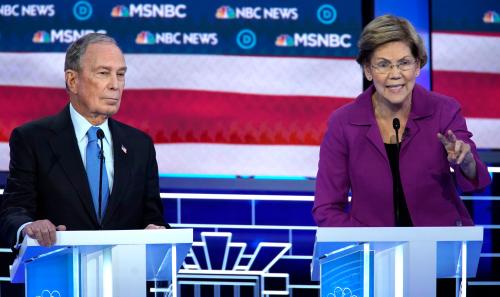
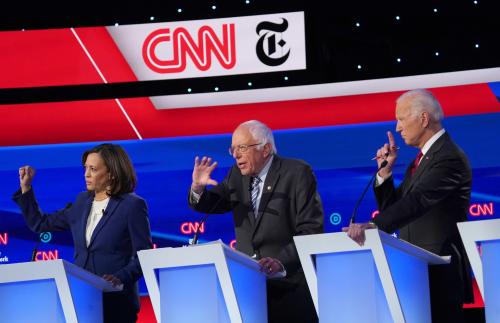
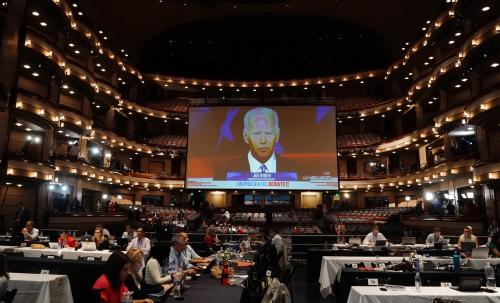

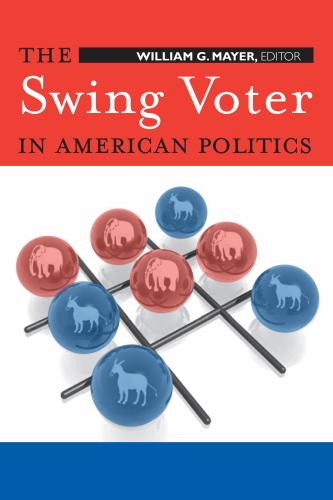
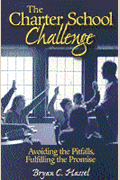




Commentary
What to watch for in the first Democratic debates
June 26, 2019